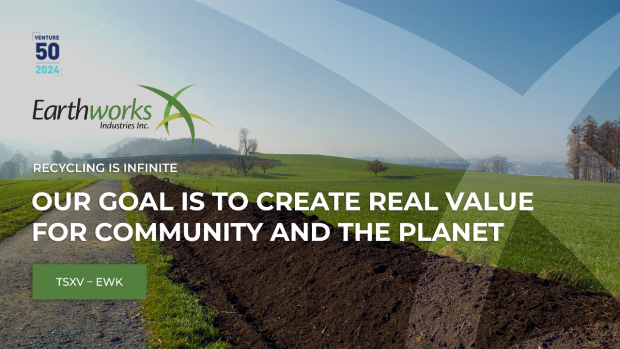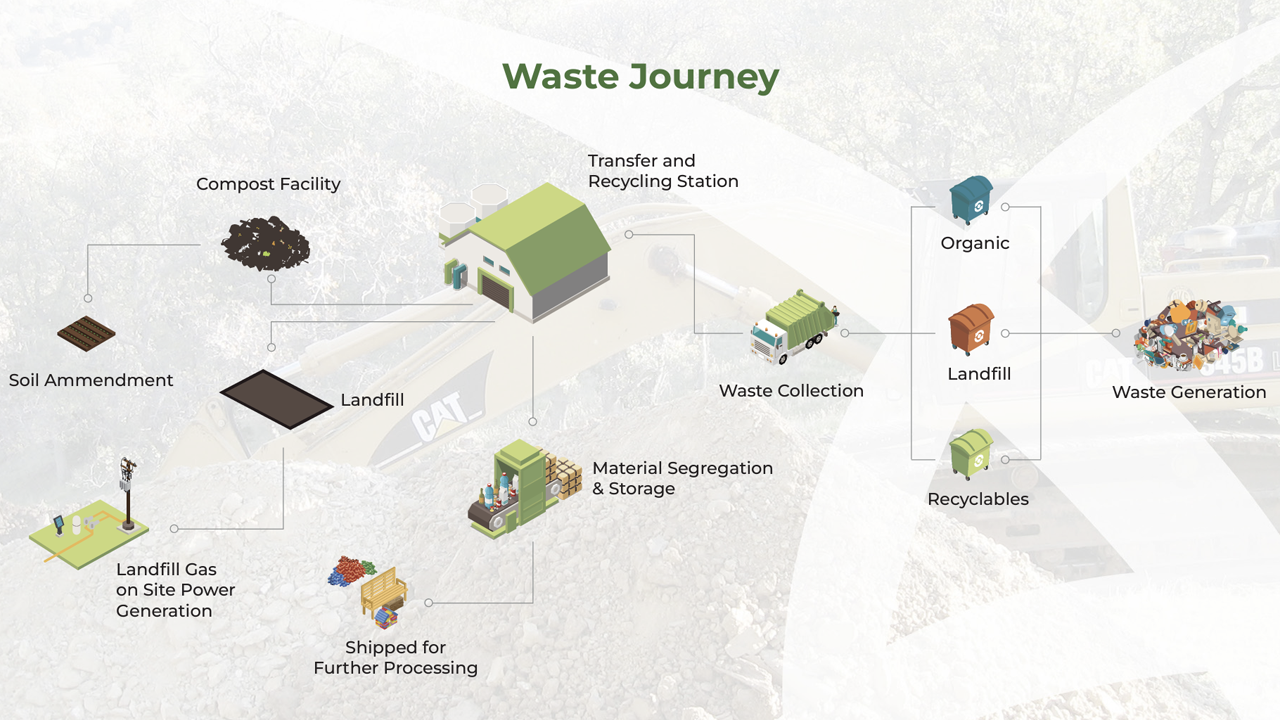Apr 2, 2024
Earthworks Industries is set to turn trash into cash
Presented by: Market One


Located high above California’s Sacramento Valley, about 160 kilometres (100 miles) northeast of San Francisco, Cortina Rancheria is a place where the land is as bleak as it is beautiful.
Little grows here of any commercial consequence and economic opportunities are scarce due to limited natural resources in the area, which is part of the tribal territory of the Kletsel Dehe Wintun Nation.
While the land here may not be good for much, it is ideal for the vision of David Atkinson, President/Chief Executive Officer of Earthworks Industries, whose work over the past decade has set the stage for a new era of waste management facilities in North America.
Vancouver-based Earthworks Industries Inc. (TSXV: EWK) is proposing development of a multi-faceted waste handling operation, which is managed by the company’s wholly owned U.S. subsidiary, Cortina Integrated Waste Management Inc. (CIWM).
With federal approval, CIWM holds a lease of 180 hectares (443 acres) of the Cortina Rancheria in California’s Colusa County for the development of the integrated waste handling facility, which includes a material recovery system, composting, contaminated soil remediation, power generation and landfill operations.
“The company has attracted significant interest from both institutional and public investors over the past year and we expect this interest to continue to grow as our project moves forward," said Atkinson.
“We feel that this project will be the next generation of waste handling and material handling facilities on this continent,” he said.
Earthworks, which was recently recognised by the TSX Venture Exchange as one of its top performing companies over the past year, is now awaiting tentative approval of the Site Specific Flexibility Requests for the landfill, from the U.S. Environmental Protection Agency (EPA), which is expected later this month.
Cortina has been in development for over a decade with an investment approaching $25 million, said Atkinson, adding the site could be operational and cash flow positive within 18 to 24 months.
“One of the key benefits of this successful regulatory process is that the precedent at Cortina will not only have significant beneficial impact in the region, but it will also potentially open the door to future similar developments by the company elsewhere in Indian Country,” said Atkinson.
Once operational the company will immediately build up the solid waste material to the facility to the current permit limit of 1,500 TPD (tons per day). Cortina will also build incremental revenue through other operations related to compost organic waste treatment material recovery and onsite gas production These operations will generate additional revenue and preserve disposal capacity. A material recovery operation will be added as onsite activities expand.
Earthworks estimates the value of the project to be between US$158 million and US$202 million based on calculations using 7% and 5% discount rates over a 25-year period. The after-tax annual cash flow rises steadily from US$13.5 million in the first full year to over US$30 million in 25 years. The lease at Cortina currently runs until January 25, 2032, with a 25-year extension option.
According to an opinion document from SCS Engineers, an environmental consulting and contracting firm, the Earthworks “proforma model developed for the proposed landfill construction and operation appears to be well structured and considers the major fixed and variable operational costs, projected revenues and capital costs associated with developing, closing and maintaining the site during the post closure care period.”

America is facing a massive garbage crisis
Atkinson’s vision taking shape in the Sacramento Valley comes at a time when the U.S. continues to generate vast amounts of waste while facing increased challenges associated with disposing of, recycling and managing this waste.
Environment America, a national network of 30 state environmental groups, said that though the United States is home to only 4% of the world’s population, America is responsible for 12% of the planet’s trash.
Americans throw out 4.9 lbs of trash per person every day — that’s nearly 1,800 lbs of materials per American every year.
In 2018 alone, the U.S. threw out over 292 million tons of municipal solid waste (MSW) — the materials discarded by homes, businesses and institutions, such as universities and libraries. The majority of waste (62%) discarded by homes and businesses in the U.S. is ultimately dumped into landfills or burned in incinerators.
When it comes to food waste, the United States discards more food than any other country in the world: nearly 60 million tons — 120 billion lbs — every year. That’s estimated to be almost 40% of the entire U.S. food supply and equates to 325 lbs of waste per person.
In terms of plastic, Greenpeace states Americans discarded 51 million tons of wrappers, bottles and bags in 2021 — about 309 lbs of plastic per person — of which almost 95% ended up in landfills, oceans or scattered in the atmosphere in tiny toxic particles.
Verisk Maplecroft, a global risk intelligence company, said America tops the list of countries fuelling the waste crisis and is “one of the worst of any industrialised nation for managing its trash” generating over three times as much waste as China.
“The U.S. is not alone though. Highly developed European and North American countries are also disproportionately responsible for the highest levels of waste generation. The highest risk countries include the U.S., the Netherlands, Canada, Austria, Switzerland, Germany, France and Australia,” said Verisk Maplecroft.
Looking forward, The World Bank estimates global waste is expected to grow to 3.40 billion tonnes by 2050, more than double population growth over the same period.
America’s waste management crisis has also been magnified with several Asian countries banning the importation of garbage from the West – a practice driven by the lower cost of recycling or disposing of waste in these countries due to less stringent environmental regulations and cheaper labour.
China, Indonesia, Malaysia, the Philippines and Thailand were among the primary recipients of the world's plastic waste, scrap metal, paper and electronic waste until about 2018 when the import bans took effect.
“The actions of these countries have underscored the critical message that there is an urgent need for nations to handle their waste within their own borders,” said Atkinson.
As countries continue to address the challenges stemming from systemic issues in how waste is produced, handled, recycled and disposed of, opportunities in this sector are also growing at a fast pace.
Grand View Research, a market research and consulting company, reported recently that the global waste management market size was valued at US$1.3 trillion in 2022 and is expected to grow at a compound annual growth rate (CAGR) of 5.4% from 2023 to 2030.
A key driver for the growth of the global waste management market size is the rise in the world’s population and the subsequent increase in waste generation. Increasing government regulations are also expected to support market growth, based on the report.
New technologies hold solutions to solve global trash crisis
“California, like many parts of North America, is facing a critical shortage of landfill capacity as the amount of solid waste material has drastically increased in the last decade,” said Atkinson.
When Earthworks’ Cortina project goes online, it will host the first landfill site to open in California in 20 years. There are now 176 operational landfills in California with 35 of those scheduled to be closed by 2030.
“Landfill disposal has continued to increase in value over the past few years. This has had a significant positive impact on the underlying value of the Cortina project… but the solutions to the growing waste management issues will rely on new technologies not just dumping trash into landfills,” said Atkinson.
“From material repurposing to energy generation, the Cortina Integrated Waste Management site will use the newest and most effective technologies to reduce its carbon footprint and other environmental impacts. We have established relationships and contacts with a wide spectrum of companies involved in all aspects of the business. From the traditional waste handling operations to emerging companies involved in the transition technologies such as anaerobic digestion, biofuel, biomass and other waste to energy applications,” said Atkinson.
Atkinson said Cortina will create a precedent by being a one-stop location “like an eco-park” to trial and use new technologies for “a new age of waste handling in the U.S.”
It is a notable development in the waste management sector, offering a new and unique model for environmentally responsible waste disposal and management in California and beyond.
To learn more about Earthworks Industries Inc., visit their website here.
For the latest updates, follow Earthworks Industries on social media: X and LinkedIn